THE EMERGENCE OF THE ROMANIAN PROFESSIONAL CLASS – PLOIESTI 1900s

Romanian Royal Cavalry 'The Redcoats' (Rosiori) Regiment - whose Honorary Colonel in Chief was Princess Marie of Edinburgh, spouse of Prince Ferdinand of Hohenzollern- Heir to the Romanian throne.
From the 1840s onwards the children of Romanian nobility were educated in Paris, Rome, Vienna, Budapest or Berlin, bringing back some modern and even revolutionary ideas: manners, dress, culture, emancipation, freedom. It was only with the consolidation of Romanian monarchy first as a Principality, under Alexandru Ioan Cuza (1859-1866) and from 1866 onwards under Prince Carol of Hohenzollern that Romania was recognized as an independent Kingdom, following the 1877 War of Independence sealed by the Treaty of Berlin. As a result of these historic changes the urgent need for skilled professionals increased and Romanians started to graduate in significant numbers from native Universities in Bucharest and Iasi respectively. The peasantry remained largely illiterate with the exception of village priests who could read and write and who doubled as village teachers. By the 1880s, after the War of independence, the children of these Orthodox prelates aspired to a higher education in the cities – the daughters went to private colleges – either convent schools, often run by the Catholic nuns (Baratie cathedral School, Notre Dame de Sion) or private boarding schools (such as Pensionul Pompilian) where they were taught foreign languages, music, painting and embroidery.
From 1890s onwards we find some young ladies who, after graduating from boarding colleges or convent schools, wanted to be gain a University education at the Faculties of Pharmacy, Medicine, Architecture Law or the Music Conservatoire, although for them professional emancipation was slow to come. By contrast, their male counterparts benefited fully from the Kingdom’s economic growth to start filling civil service positions previously held by foreigners – Austrian, German or French graduates. This marked the birth and ascendancy of the native Romanian professional and political classes from 1880 to 1947.
With the occupation of the Soviet armies in 1944 and sudden imposition of a new (communist) order, those professionals who resisted the change and who practiced liberal professions (in Pharmacy, Medicine, Law, Finance or served in the Army) and did not join the Communist Party, were at best expropriated, or marginalised, left without any means of survival. This fledgling middle class was systematically destroyed by being dragged to jail on trumped up charges, forced into hard labour camps, digging the Danube-Black Sea Canal, harvesting reeds in the Danube Delta, or working as slave labour in the Carpathian copper mines.
From 1949 onwards the Communist Party devised fast-track courses for “reliable” substitutes, selected from people with no previous college education to “qualify” as engineers, leaders of Industry or hospitals: this system involved a few months of “intensive” education (…). If, as a result of incompetence, or lack of experience, the new ruling class-on-the make, failed in its duty, then the old professional class served as convenient scapegoats: by the mid 1950s, those Romanian professionals who were not yet reduced to pulp were blamed instead for the ensuing failures and charged with ‘economic sabotage’. Once the educated elite was effectively decapitated, Romania became a prison-state under the iron fist of dictators Gheorghiu-Dej (1948-1965) – an electrician and his cobbler successor Nicolae Ceausescu (1965-1989).
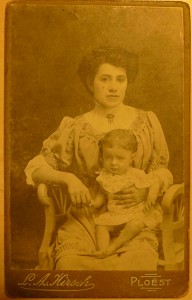
Doamna Stefania Livovschi (nee Burada) with her son Valeriu. ( L.A. Hirsch Ploiesti 1908. Fotografia Bulevard)
The lady seen in this photo is Stefania Burada, whose ancestors during the 19th century founded schools and parish churches in the vast steppes of the Danube Plains, which became the ‘granary of Europe’. Born in the 1880s, in rural Romania, Stefania was herself the daughter of Reverend Constantin Burada, a parish priest who founded the local rural school where he served as School Master. She was the youngest of a large brood of children most of whom died prematurely of diphtheria. From amongst these only two children survived, being isolated, away from home, on the country estate of their maternal grandfather’s himself a priest in another village of the Danube Plains. Stefania and her younger brother Constantin reached adulthood, both of them receiving higher education: Constantin Burada read Law in Bucharest to become a judge at the High Court of Appeal (Inalta Curte de Casatie), whilst Stefania was educated at the Pompilian Boarding College in Calea Rahovei, Bucharest. Here she proved to be a gifted pupil in the class of a Transylvanian painter, Sava Hentia (1848 – 1904), who was schooled at the Accademia di Luca in Rome. This famous art school, founded in the 17th century, produced an array of artists of international repute, such as Simon Vouet, Charles Le Brun, Antonio Canova, to name just a few.
At the Pompilian College Stefania Burada became a close friend of Ecaterina Livovschi who like herself was the daughter of an Orthodox prelate, a teacher of Religious Education and Rector of St Nicholas cathedral in Tulcea. Ecaterina went on to study Medicine to become an Ophtalmologist. Stefania married Ecaterina’s eldest brother Vicentiu a graduate in Pharmacy, from the University of Bucharest. In the early 1900s the couple settled in Ploiesti, where Vicentiu bought a short lease on a Pharmacy.
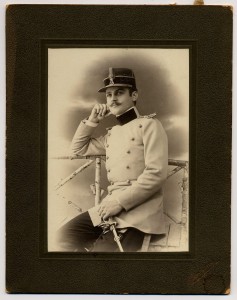
Vicentiu Livovschi as Captain of the Tulcea Regiment of the Royal Romanian Army. After graduating in Pharmacy at the University of Bucharest he married and leased at Ploiesti the "Farmacia Mihai Bravul"
The Livovschi offspring were all born before WWI (the eldest of whom is seen in the picture above, with his mother). All children became University went to University Applied Chemistry and Pharmacy or modern languages.
At the turn of the century Ploiesti was a booming city with a fast economic growth, due to the oil Industry. Oil was extracted on an industrial scale since 1856 to make Romania Europe’s second largest oil producer, after Russia. Here were present French, Dutch, Belgian, American and British oil companies drilling for oil and refining it locally to export it from the Danube ports to Central Europe or respectively from the Black Sea port of Constanta to Western Europe. By the early 1900s when the Livovschi moved to Ploiesti the surrounding countryside looked like the American ‘Wild West’, with a forest of oil derricks and Canadian pumps called ‘nodding donkeys’.
Before WWI Stefania’s family gained in Ploiesti a high profile and social status as her husband got the lease of a main pharmacy in downtown – the “Farmacia Mihai Bravu”.
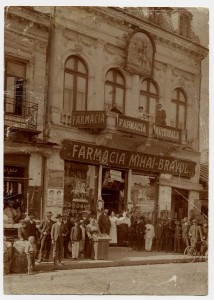
"Farmacia Mihai Bravul" Ploiesti leased by Vicentiu Livovschi (seen on the balcony with his wife and son) Photo 1908. The man in a three-piece suit standing in front of the Pharmacy entrance below is the father of the composer Paul Constantinescu.
The pharmacy belonged to a Mr Schmettau (probably an Austrian national) and was leased for a period of five years (1906-1911) to the 30-years old Romanian pharmacist, Vicentiu Livovschi. Vicentiu represented the first generation of home-grown professional middle classes, educated in Romania. Beyond his professional activity he played the violin whilst his two sisters, Ecaterina a graduate in Medicine and Emilia a Pharmacist played the cello and the violin respectively. Together the three siblings founded in Ploiesti the first classic music orchestra – “The Excelsior”. Although Vicentiu and Stefania were newcomers to Ploiesti they already had in the city several uncles, one of whom, Reverend Anghel Burada a paternal uncle was rector of St Basil Orthodox Church (Biserica Sf Vasile) and a maternal uncle Rev. Chiriac Dobreanu was Rector of Sf Ilie Tabaci Orthodox Church. So far as the intermarriages were concerned it is noteworthy that that the wife of Rev Anghel Burada, known as ‘Mitza Presbitera’, or ‘Coana Mitza’, was related to the artist painter George Ioachim Pompilian, who in 1872 was busy painting the iconostasis of St Basil church Ploiesti. Ioachim Pompilian studied Fine Arts at the Accademia di San Lucca in Rome and was himself the son of yet another Orthodox prelate, Reverend Ioachim Ioachimescu, One must recall that Stefania Livovschi, nee Burada, was educated at the Pompilian College run by Ioachim’s family, which was related to her uncle the Rev Anghel Burada. Ioachim Pompilian went on to restore and decorate the internal frescoes of the Metropolitan cathedral in Bucharest.
Judging from the perspective of narrow family angle one could say on the whole that the social life in Ploiesti during the 1900s was very tightly knit, being based on strong tribal links. This is understandable, as all family cousins in Ploiesti were part of the new crop of professionals destined to play a crucial part in the economic, social and political life of interwar Romania, a pattern which was replicated throughout the country. The Livovschi family passage through Ploiesti was curtailed by the First Balkan War when Vicentiu was conscripted to serve as a Captain in the Royal Romanian Army which occupied Bulgaria. As a result of this war Romania gained the territory of Southern Dobrogea which included Balcik a seaside village made fashionable by Queen Marie who built a retreat there: artists soon followed suit to form a small colony known as the “School of Balcic” – of post-Impressionist and fauvist persuasion. On being demobbed and returning to Ploiesti Vicentiu was faced by Mr Schmettau requiring a substantial increase in renewing his lease. As a result, by 1914 we find vicentiu Livovschi a Pharmacist owner of the “Drogheria Centrala” opposite the Townhall of Buzau. (see THE EMERGENCE OF THE ROMANIAN PROFESSIONAL CLASS (2) – BUZAU – 1914 – 1948)
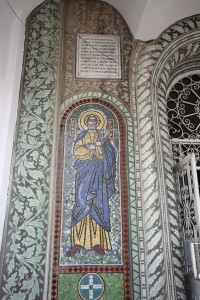
St Basil Orthodox Cathedral church (biserica Sf. Vasile) Ploiesti - marble plaque commemorating Rev. Anghel Burada


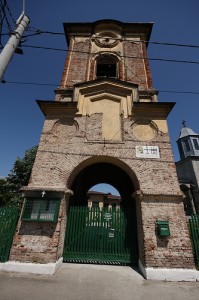
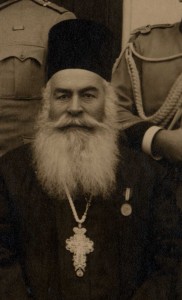

No Comments so far ↓
There are no comments yet...Kick things off by filling out the form below.